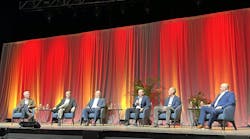The evolution of lighting technology to include not just lamps and fixtures but the whole systems that control how a space is lit and the energy used to light it has been driving manufacturers in the lighting market to expand their product scope to include lighting controls, primarily through acquisitions of existing companies that have had success developing these systems. Increasingly, that lighting control is integrated with broader energy management systems, carrying the industry’s lighting companies into new territory.
The latest instance of this trend came this week, when Osram Sylvania, the Danvers, Mass.-based lighting subsidiary of Siemens, announced it has signed an agreement with Townsend Ventures, LLC, to increase its stake in Encelium Technologies from 15 percent to 100 percent.
Financial terms of the deal were not disclosed.
In announcing the move, Osram said taking full ownership of Encelium will improve its position in two key global growth markets, LED-based technologies and lighting controls, or what the company calls Light Management Systems (LMS).
Encelium, headquartered in Teaneck, N.J., is essentially a software technology development company concentrating on advanced, addressable lighting control and energy management systems for commercial and industrial buildings. Since its founding in 2001, Encelium has grown to employ approximately 70 people in the United States and Canada. Taken under the Osram Sylvania umbrella, Encelium will become part of Osram’s General Lighting – LMS business unit, which includes the rest of the company’s lighting management products. The Encelium brand will continue to be developed, Osram told Electrical Marketing, alongside the company’s existing lighting control, which are primarily focused on the Optotronic brand.
“The acquisition of Encelium, and its cutting edge lighting control software for commercial buildings, is the next logical step for OSRAM in becoming one of the leading LED lighting solutions providers,” said Klaus-Gunter Vennemann, CEO of General Lighting at Osram, in a release announcing the deal. “Today lighting is responsible for 20 percent of electrical energy consumption globally. In the U.S. it accounts for more than 30 percent of the commercial building’s electrical energy consumption. With an ever-increasing demand for improved energy efficiency of commercial buildings, this acquisition enables us to offer smart LMS options to our customers worldwide that provide the right light, in the right amount, at the right place, at the right time.”
Some members of the Encelium management will join Osram to continue developing Encelium’s Energy Control System (ECS) technology, but others are taking the opportunity to retire. “Osram Sylvania is interested in continued collaboration with the current management of Encelium,” Osram Sylvania spokesperson Stephanie Anderson told EM. “We are pleased that several executives are planning to continue their successful careers as part of Osram Sylvania. Others, who were looking forward to retiring, have agreed to support us through the transition, as Encelium is gradually integrated into the Osram Sylvania Light Management Systems organization.”
Siemens initially invested in Encelium Technologies in Dec. 2010 when its Siemens Venture Capital organization led a financing round to secure $11 million to help Encelium expand.
Encelium’s website describes its Energy Control System (ECS) as “an intelligent, integrated lighting control and energy management solution that uses the collaborative power of addressable networking technology in conjunction with advanced control hardware and software.”
Essentially the technology allows each person in a commercial building to control their own workspace light levels from their desktop computer. The integrated system also allows facility managers to make full use of six separate energy management strategies. Those include daylight harvesting, which adjusts interior light levels according to available daylight; occupancy controls to turn lights on and off automatically; smart time scheduling to adjust light where occupancy sensors are not appropriate; task tuning to set default light levels to suit a particular workspace; personal software-based controls for individual occupants to adjust their workspace lighting by need or preference; and variable load shedding, which limits power demand peaks to reduce overall utility costs.
Osram further said LMS is a key growth market as lighting controls support the transition of standard lighting products to networked, intelligent and value-added solutions. According to a recent McKinsey study, the current global market volume for lighting systems control components is roughly estimated at €2 billion. This is expected to double by 2016 and triple by 2020.








